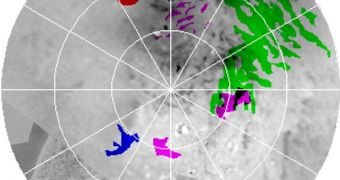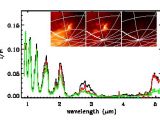Astronomers were puzzled to discover fog on Titan, one of Saturn's most intriguing moons. In spite of the fact that they knew it supported an active methane hydrological cycle, the team had absolutely no idea that surface-atmosphere exchanges appeared as well. The find is the first ever to reveal the fact that the moon's hydrological processes are similar to those on our planet. However, it is safe to say that the fog was not made up of water vapors, as Titan is covered in hydrocarbon lakes, most notably methane, arXiv reports.
The observations that led to the discovery of fog were conducted using the Visible and Infrared Mapping Spectrometer (VIMS) instrument, aboard the Cassini spacecraft. The investigation was done by M.E. Brown, A.L. Smith, and C.Chen, all from the California Institute of Technology (Caltech) Division of Geological and Planetary Sciences. M. Adamkovics, from the University of California in Berkeley (UCB) Department of Astronomy also contributed to the research.
The team's conclusions point at the fact that the fog in Titan's atmosphere could only have formed from the evaporation of liquid methane or ethane from the lakes on the surface. In recent studies, it was revealed that the late summer season on the moon was a time when the South Pole regions were filled with liquid hydrocarbons, and many lakes featuring methane and/or ethane were formed. The entire moon is laden with liquid-carved channels, clouds, polar lakes, and other changes, which all point at the fact that its hydrological cycles are very well developed and pretty much active.
“VIMS is a hyperspectral imager, obtaining near-simultaneous images in up to 256 channels between 1 and 5 μm. This capability, coupled with several strong methane absorption features in Titan's atmosphere throughout this spectral region, allows us [to] sum multiple wavelength images to construct synthetic filters which probe to different depths in Titans atmosphere,” the researchers write in their paper. “Fog, if present, would appear as a bright feature, visible in the synthetic filter which probes all the way to the surface, but not visible in the filters which probe only to higher altitudes.”
“Fog forms when the vapor in ground-level air saturates and condenses. On the earth, this saturation can commonly occur when air radiatively cools overnight until it reaches the dew point. On Titan, such a formation mechanism is impossible. Fog on Titan instead requires elevated surface humidity. If the fog is at ground level, the surface relative humidity must be nearly 100%. Such an elevated surface humidity occurs if the surface air is in contact with nearly pure evaporating liquid methane,” the team concludes.

 14 DAY TRIAL //
14 DAY TRIAL // 

